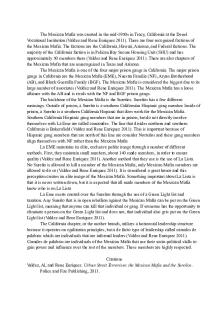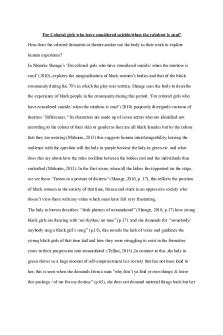Enteral Nurtrition post test 2 PDF

| Title | Enteral Nurtrition post test 2 |
|---|---|
| Author | Lisbeth Valencia |
| Course | Nursing Fundamental Concepts |
| Institution | Herzing University |
| Pages | 3 |
| File Size | 90.2 KB |
| File Type | |
| Total Downloads | 68 |
| Total Views | 150 |
Summary
The study material for enteral nutrition post-test....
Description
1. 1.ID: 18668364817 The nurse is inserting an NG feeding tube for the first time. Which action, if made by the nurse, indicates further instruction is needed? A.
The nurse dips the end of the tube into a glass of water to activate the lubricant.
B.
The nurse has the patient flex the head as the tube is inserted into the naris. Correct The nurse should have the patient flex the head toward the chest after the tube has passed the nasopharynx because this closes off the glottis and reduces the risk of the tube entering the trachea. Flexion of the head as the tube is inserted into the naris is unnecessary and may make the passage of the tube through the nasopharynx more difficult. Dipping the tube into a glass of water activates the surface lubricant to facilitate passage of the tube into the naris to the GI tract. The nurse should aim back and down toward the ear. Natural contour facilitates passage of the tube into the GI tract. Swallowing facilitates passage of the tube past the oropharynx.
C.
The nurse aims back and down toward the ear.
D. The nurse advances the tube as the patient swallows. Awarded 1.0 points out of 1.0 possible points. 2. 2.ID: 18668364823 You have inserted an NG feeding tube. The patient vomited during insertion and continues to gag. What action(s) should you take? (Select all that apply.) A.
Suction airway as needed. Correct
B.
Place patient in high-Fowler's position.
C.
Position patient on side. Correct
D.
Contact health care provider for possible chest x-ray. Correct
E. Have patient sip ice water. Persistent gagging leads to vomiting with aspiration of GI contents. You should position the patient on the side, and suction the airway as needed. The health care provider should be contacted and consideration made of the need for an immediate chest x-ray film. Awarded 3.0 points out of 3.0 possible points. 3. 3.ID: 18668364825 The health care provider just left the patient’s room after explaining the options of NG or NI feeding tube placement. A student asks a nurse about the differences between nasogastric and nasointestinal feedings. Which of the following are accurate statements made by the nurse? (Select all that apply.) A.
Insertion of an NG tube requires clean gloves, whereas insertion of an NI tube requires sterile gloves.
B. C. D.
Gastric aspirate is expected to have a lower pH than intestinal aspirate. Correct The advantage to an NI tube is that there is less risk for aspiration. Correct NI tubes are used for patients with nasal problems such as nosebleeds or deviated septums. NG tubes are used for patients without nasal problems.
E. Both NG and NI tubes are usually used for less than 30 days. Correct Gastric aspirate is expected to have a pH less than 5 in a fasting patient, whereas intestinal pH is expected to be 6 or higher. There is believed to be less risk of aspiration with a nasoenteric tube because it is placed beyond the pylorus. Both NG and NI tubes are used for less than 30 days. Patients needing tube feedings for a longer period are candidates for a more permanent solution, such as a gastrostomy or jejunostomy tube. Awarded 3.0 points out of 3.0 possible points. 4. 4.ID: 18668364821 The patient’s wife is watching as the nurse prepares to insert a small bore feeding tube. She asks the nurse, "What is the purpose of the guide wire?" The nurse correctly responds: A. B. C.
"Because placement must be verified by a chest x-ray, the guide wire is used to determine correct placement when it shows up on radiography." "To keep the patient from pulling the tube out as readily." "To serve as a guide to determine when the correct length of tubing has been inserted."
D.
"Because feeding tubes are flexible, a guide wire or stylet is used to provide rigidity that facilitates positioning." Correct The guide wire or stylet provides rigidity that facilitates positioning and is removed once correct placement is verified via a chest x-ray. The tip of the feeding tube contains a radiopaque material that will show up on the x-ray of the chest/abdomen to verify feeding tube placement. Once measured, tape or indelible ink is placed on the tube to indicate the length at which the nurse should stop inserting the tube. Awarded 1.0 points out of 1.0 possible points. 5. 5.ID: 18668364819 The patient begins to cough and choke as the nurse is inserting the NG tube. What is the best action for the nurse to take at this time? A. B.
C.
Pull the feeding tube out and start over in the opposite naris. Pull the tube back into the posterior nasopharynx and attempt to reinsert. Correct The nurse should first pull the tube back without removing completely and attempt to reinsert. If the patient is already choking drinking water will not help. If the patient is coughing or choking, the tube has most likely entered the airway. Instruct the patient to take small sips of water and swallow.
D. Auscultate over the carina. Awarded 1.0 points out of 1.0 possible points. 6. 6.ID: 18668364827 For intestinal placement of a feeding tube, in what position should the nurse place the patient while waiting for radiological confirmation of correct placement? A.
On the patient’s right side Correct Placing the patient on the right side promotes passage of the tube into the small intestine (duodenum or jejunum).
B.
In a high-Fowler’s position
C.
In a left lateral position
D. Lying flat Awarded 1.0 points out of 1.0 possible points....
Similar Free PDFs

Enteral Nurtrition post test 2
- 3 Pages

Enteral Nurtrition post test 5
- 4 Pages

Infectious control post test 2
- 4 Pages

Airway management post test 2
- 4 Pages

Enteral Feedings
- 1 Pages

Patho pre/ post Test
- 4 Pages

ATI - Profession Post test
- 2 Pages

Quizlet Informatics Post Test
- 2 Pages

Week 2 Post - Week 2 Post
- 1 Pages

Blog post #2 - post 2 online
- 1 Pages

Enteral Feeding Case Study
- 3 Pages

Unit 9 Post Test - Quiz
- 9 Pages
Popular Institutions
- Tinajero National High School - Annex
- Politeknik Caltex Riau
- Yokohama City University
- SGT University
- University of Al-Qadisiyah
- Divine Word College of Vigan
- Techniek College Rotterdam
- Universidade de Santiago
- Universiti Teknologi MARA Cawangan Johor Kampus Pasir Gudang
- Poltekkes Kemenkes Yogyakarta
- Baguio City National High School
- Colegio san marcos
- preparatoria uno
- Centro de Bachillerato Tecnológico Industrial y de Servicios No. 107
- Dalian Maritime University
- Quang Trung Secondary School
- Colegio Tecnológico en Informática
- Corporación Regional de Educación Superior
- Grupo CEDVA
- Dar Al Uloom University
- Centro de Estudios Preuniversitarios de la Universidad Nacional de Ingeniería
- 上智大学
- Aakash International School, Nuna Majara
- San Felipe Neri Catholic School
- Kang Chiao International School - New Taipei City
- Misamis Occidental National High School
- Institución Educativa Escuela Normal Juan Ladrilleros
- Kolehiyo ng Pantukan
- Batanes State College
- Instituto Continental
- Sekolah Menengah Kejuruan Kesehatan Kaltara (Tarakan)
- Colegio de La Inmaculada Concepcion - Cebu



